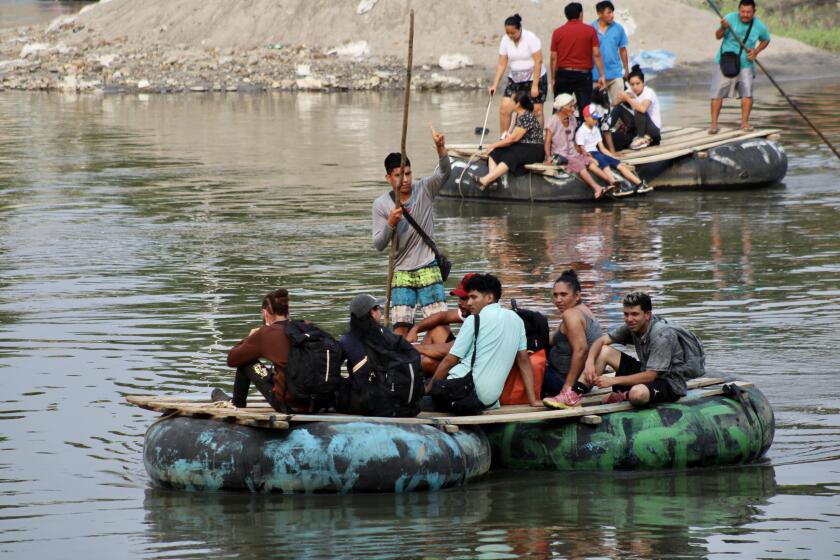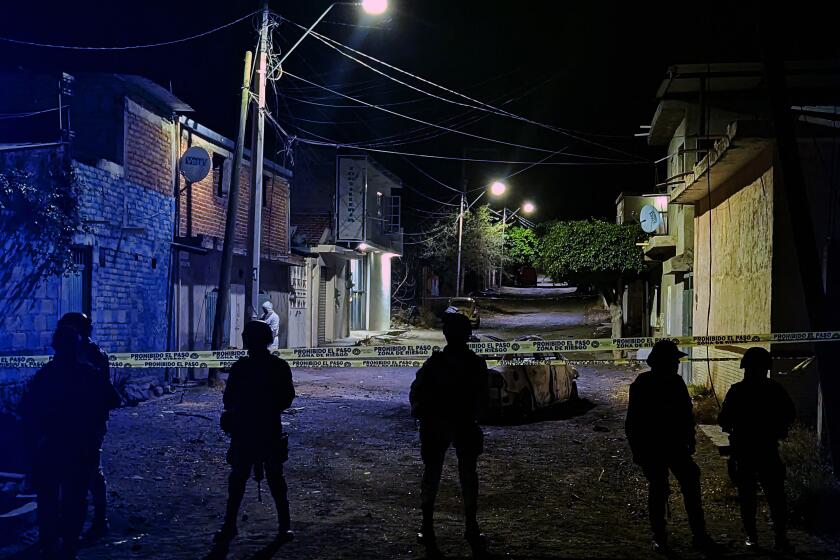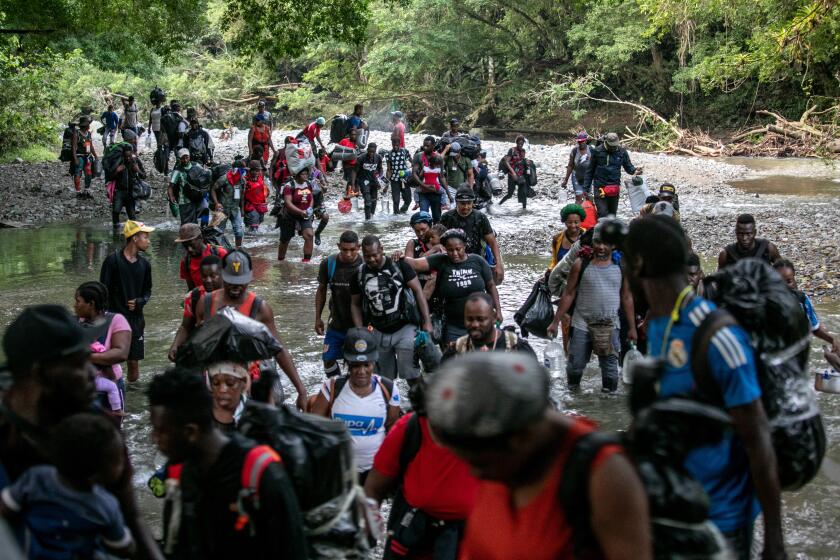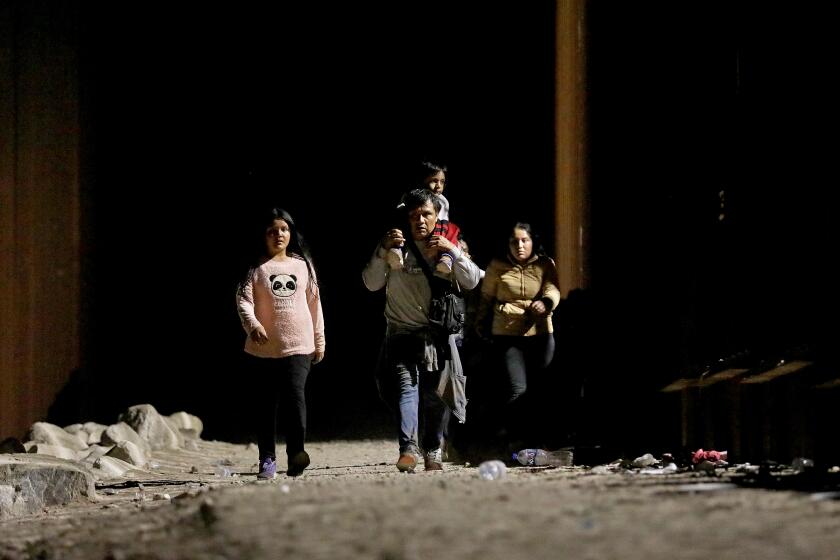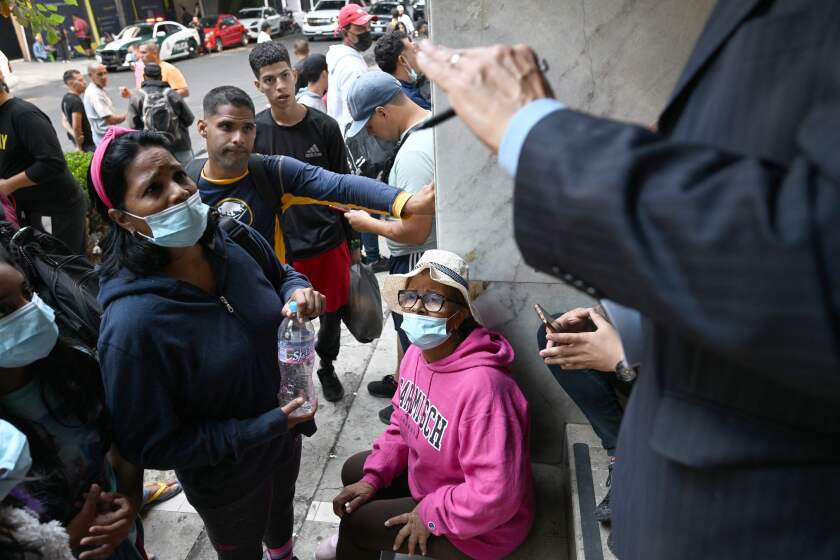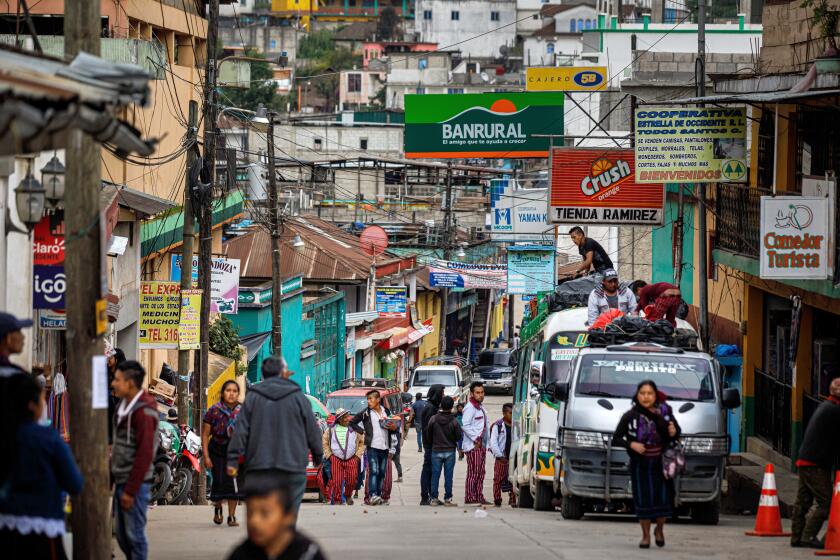
- Share via
EAGLE PASS, Texas — They waded across the Rio Grande holding hands to form a human chain as frustrated Texas National Guard members shouted warnings in Spanish from behind stacked-up coils of razor wire.
“Go back! You’re breaking the law!”
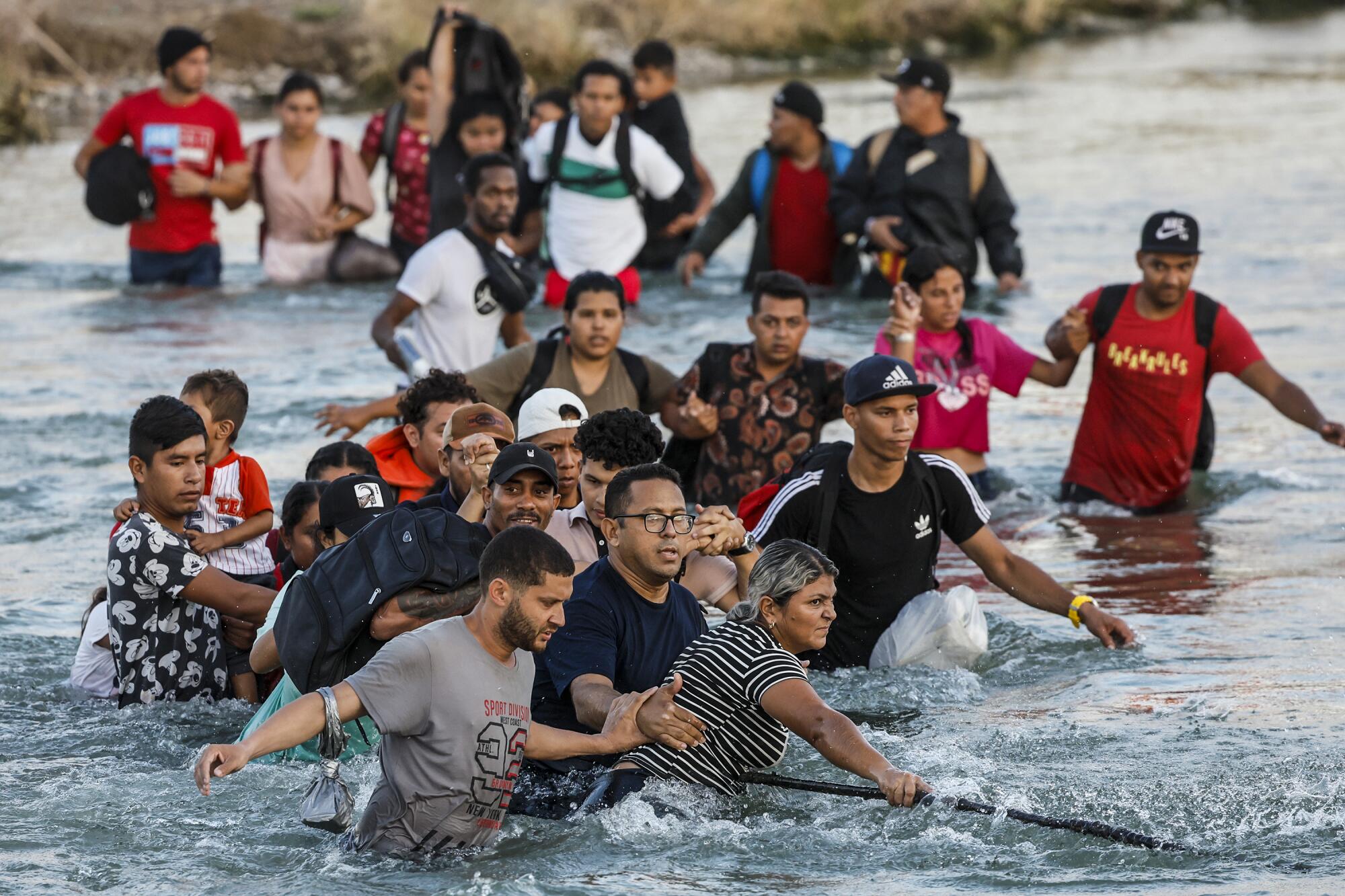
“The current is too strong! Don’t risk your lives!”
A voice came from the river: “We have children! Help us!”
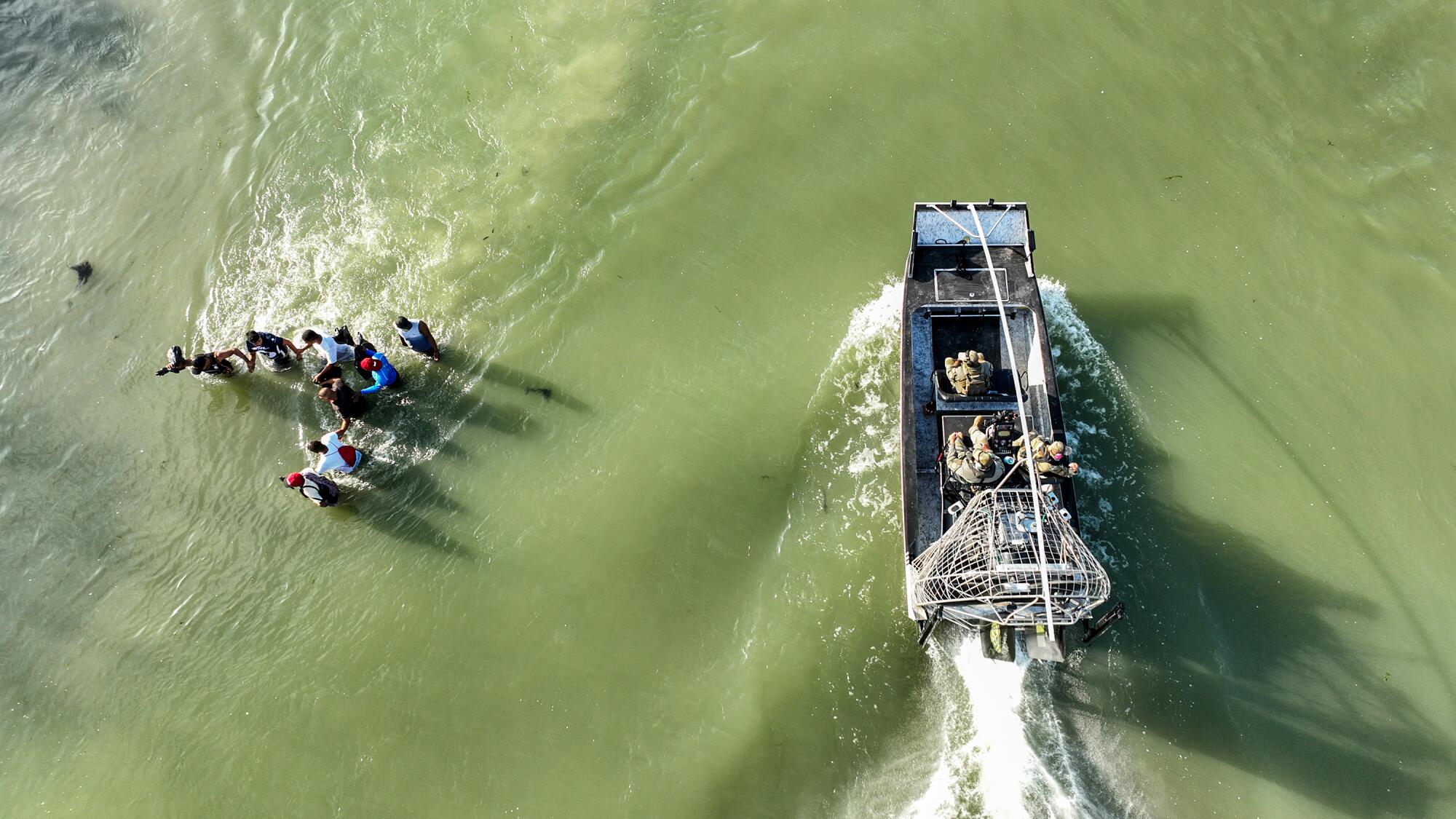
The official admonitions were to no avail. Worried that the migrants ascending the muddy riverbank into Texas could tumble back into the swift current, U.S. Border Patrol agents used pliers to cut open a passage through the thickets of barbed wire.
Litbirhec Correa, 21, from Maracay, Venezuela, clambered through with her two young children.
“Finally, we are here!” she declared.

Scenes like this unfold day and night in Eagle Pass and across much of the 2,000-mile U.S. border with Mexico.
Some 93,000 migrants traveling as families were taken into custody in August — the most ever recorded in a month — as overall Border Patrol apprehensions were up 82% compared with June.
September totals have not been released, but sources familiar with Border Patrol data said that apprehensions — including detentions of many men crossing solo — have been climbing rapidly, topping 8,000 on several recent days.
The number of Venezuelans in particular has been spiking. U.S. border officials apprehended more than 11,000 people from Venezuela in July and 22,000 in August — and the September total is expected to be even higher. With detention space limited — especially for families — many are being released while they wait for judges to consider their asylum claims.
The chaotic border scenario has become a crisis for President Biden, who is facing criticism not only from his usual Republican enemies but also from some Democrats who say their communities cannot afford the costs of absorbing the newcomers.
Following the expiration of Title 42, U.S.-bound migrants are still arriving at Mexico’s southern border to travel north, in a chaotic scene.
Rolando Salinas, the Democratic mayor of Eagle Pass, recently declared a “state of disaster,” lamenting on Facebook that his border town, home to 28,000 people, had been “abandoned” by the Biden administration.
His city has become an especially popular crossing spot.
“We are so thankful to be here,” Correa said, clutching her daughter, Leoneli, 4, and her son, Joeli, 6. “We’ve been walking for two days. All we had to eat were crackers. We must thank God.”
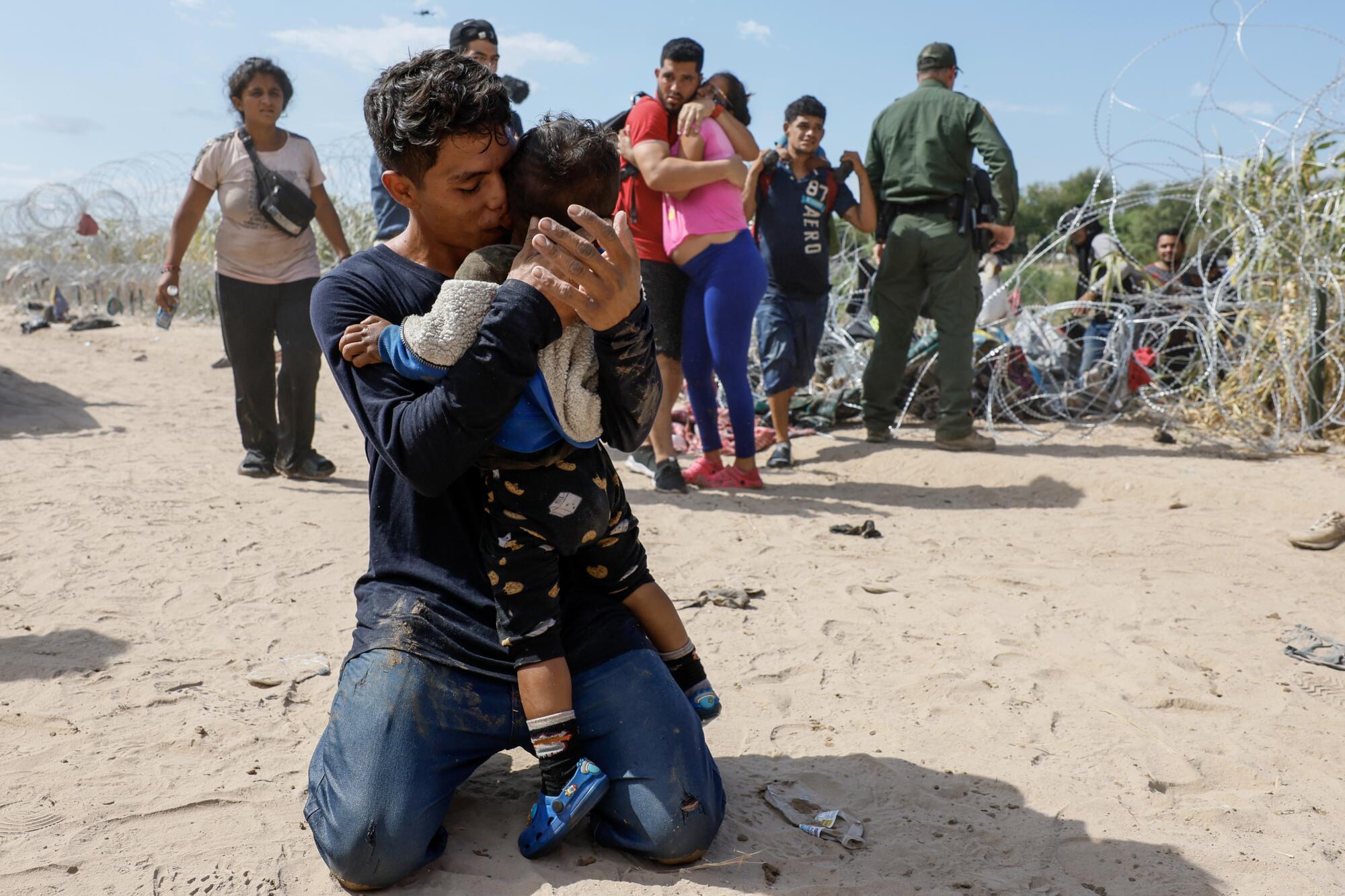
Shortly after she and others passed through the razor wire, National Guard troops rolled out fresh loops to patch the hole — even though it would soon have to be reopened.
: :
The razor wire is part of Operation Lone Star, as Texas Gov. Greg Abbott dubs his controversial campaign to deter migrants.
Farther upriver, a row of shipping containers blockading entry form what Abbott calls a “steel wall.” The federal government is suing Texas for another impediment — a line of wrecking-ball-sized orange buoys positioned in the middle of the Rio Grande.
None of the tactics has worked. If border agents don’t cut the wire, crossers deploy blankets and items of clothing to climb over the obstruction, or tunnel through it, often ending up bloodied.
A study published in Science estimated that Mexican cartels recruit about 360 workers each week to replace those lost to violence or incarceration.
Multicolored remnants of torn fabric cling to the jagged barbs, blowing in the breeze like tattered flags along a shoreline littered with discarded shoes, backpacks, jeans and other detritus from the odysseys to the United States.
Word of mouth and online chats have led them to this juncture in Eagle Pass, across the Rio Grande from the Mexican city of Piedras Negras.
“We’ve heard there’s no kidnappings here, no cartels,” said Luis Villalobos, 33, one of a large group of exhausted Venezuelans taking a break outside a grocery store in Mexico on their way to the border crossing. They still had about 30 miles to walk beneath a blazing sun in 100-degree-plus temperatures.
Francys Lira, 42, a mother of four, was accompanied by her 14-year-old son.
“They say it’s easier to get in with kids,” said Lira, repeating what has become conventional wisdom. By court order, the U.S. government cannot detain families with children for more than 20 days.
U.S. officials recorded 100,441 encounters with migrants at the border last month — nearly triple the total in February 2020.
Though most of the migrants claim asylum, nearly all of those interviewed near the border cited economic opportunity, not political persecution, as their motivation for coming.
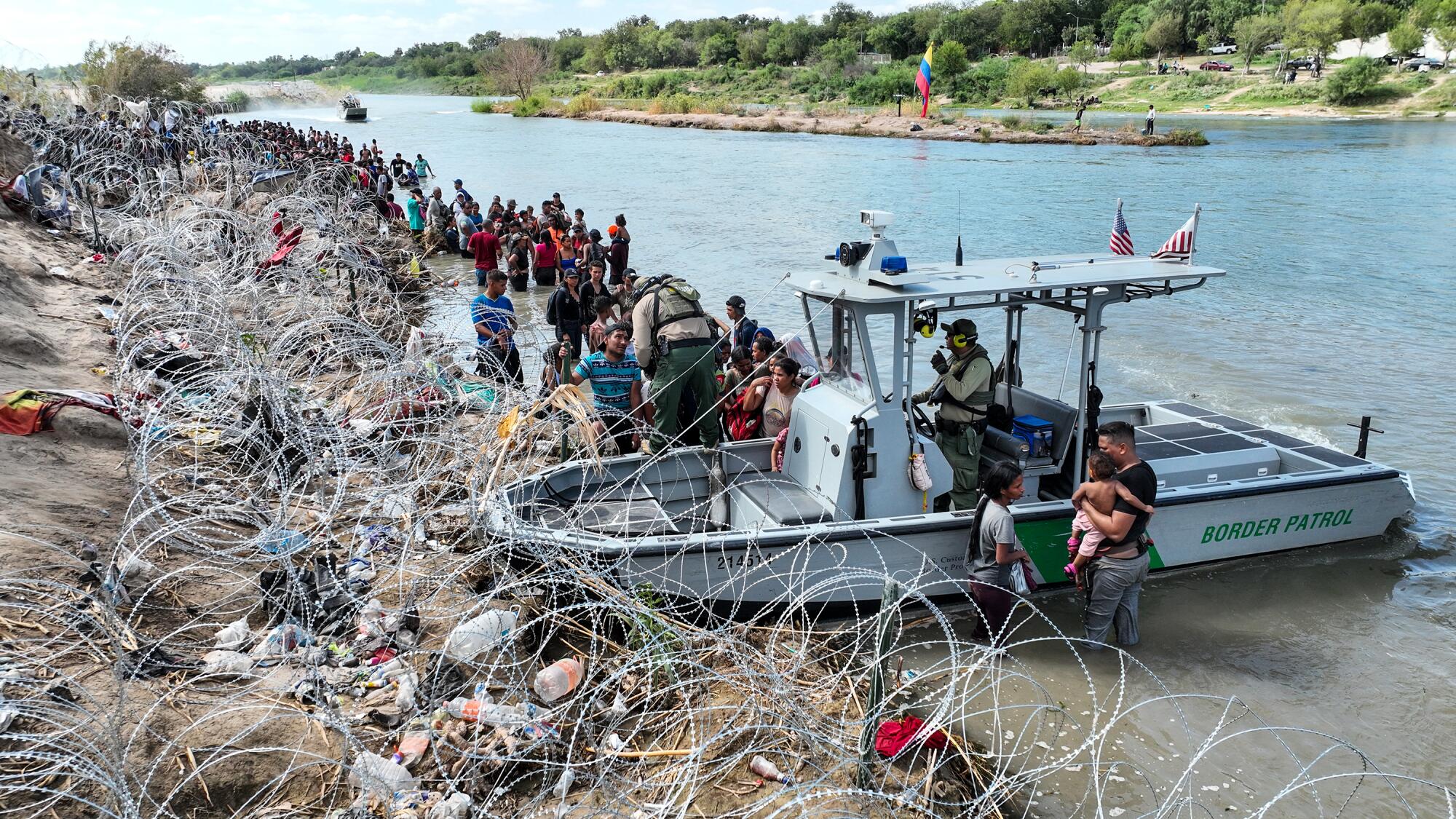
“We are 11 people, all from Puerto Cabello, Venezuela,” said Maxina Cereño, 57, after she and the others tossed their backpacks over the barbed labyrinth and crawled through an opening. “We have heard from family and friends that life is better here, so we decided to come as well. What future do we have in our country?”
Like so many others, Cereño carried a small sheet of paper with a handwritten name and telephone number — of her son, who now lives in Florida. That’s where she and the others were headed.
She recounted the group’s long journey: from Venezuela to Colombia and on foot into Panama through the Darien Gap, a once-treacherous strip of rainforest that has become a well-organized and relatively safe migrant corridor — with a record 80,000-plus people, the majority of them Venezuelans, traversing it in August.
Migrants from Haiti and around the world are camped out in northwest Colombia, a staging ground for the harrowing trip to the United States.
Then Cereño and her group moved on to Central America and Mexico, eventually covering more than 3,000 miles through jungles, mountains, cities and deserts, dodging thieves, crooked cops, extortionists and kidnappers.
The river currents here present another hazard. On a recent morning, a woman from Mexico clung to her daughter mid-river, too scared to move.
A pair of Venezuelan men strung together ropes and belts collected from other men to create a safety line for the woman. They carried 1-year-old Olga to the shore.
“I’m very grateful,” the woman, Wendy Pacheco, 24, said later as National Guard troops hoisted her and her child over a metal container barrier and handed them over to the Border Patrol.

: :
Relatively few migrants are seen on the streets of Eagle Pass, despite the mayor’s public complaints. Federal officials have gone to extraordinary lengths to keep the migrants mostly out of sight.
The Border Patrol has set up a makeshift processing center in the shadow of an international bridge just a few yards from the river. Generators power strobe lights and other equipment.
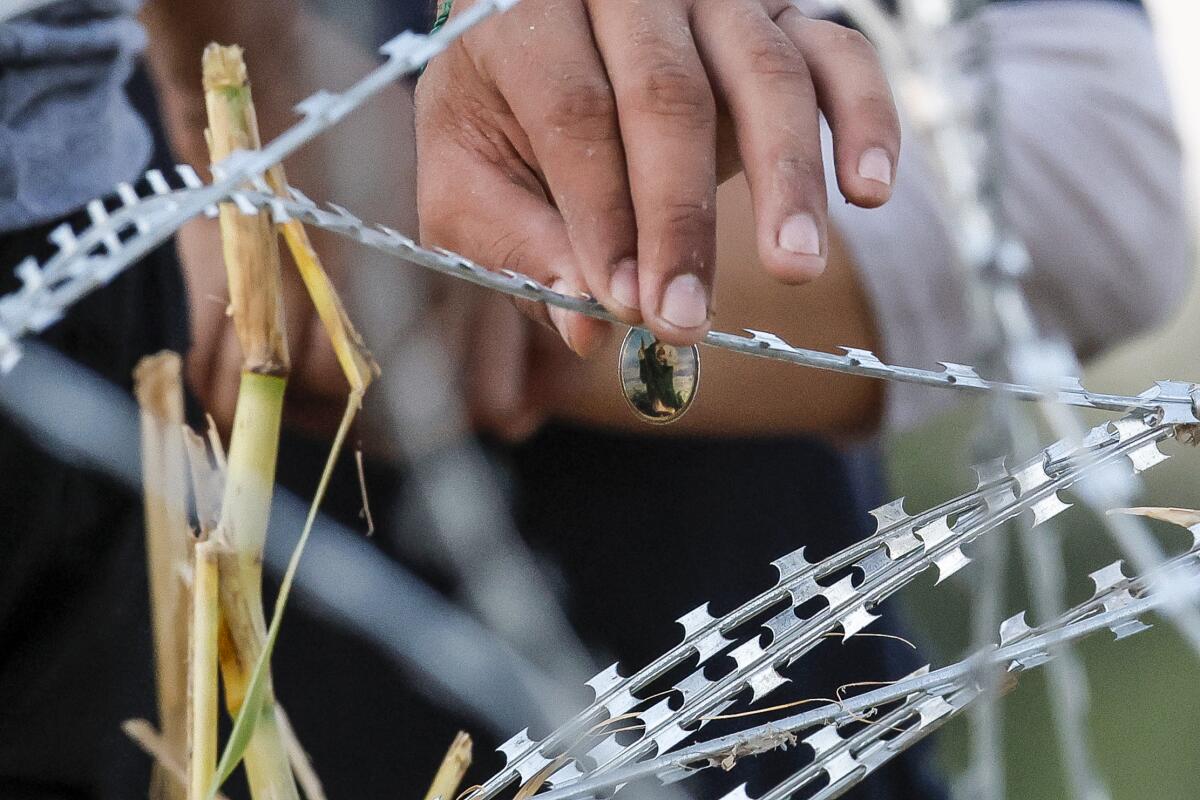
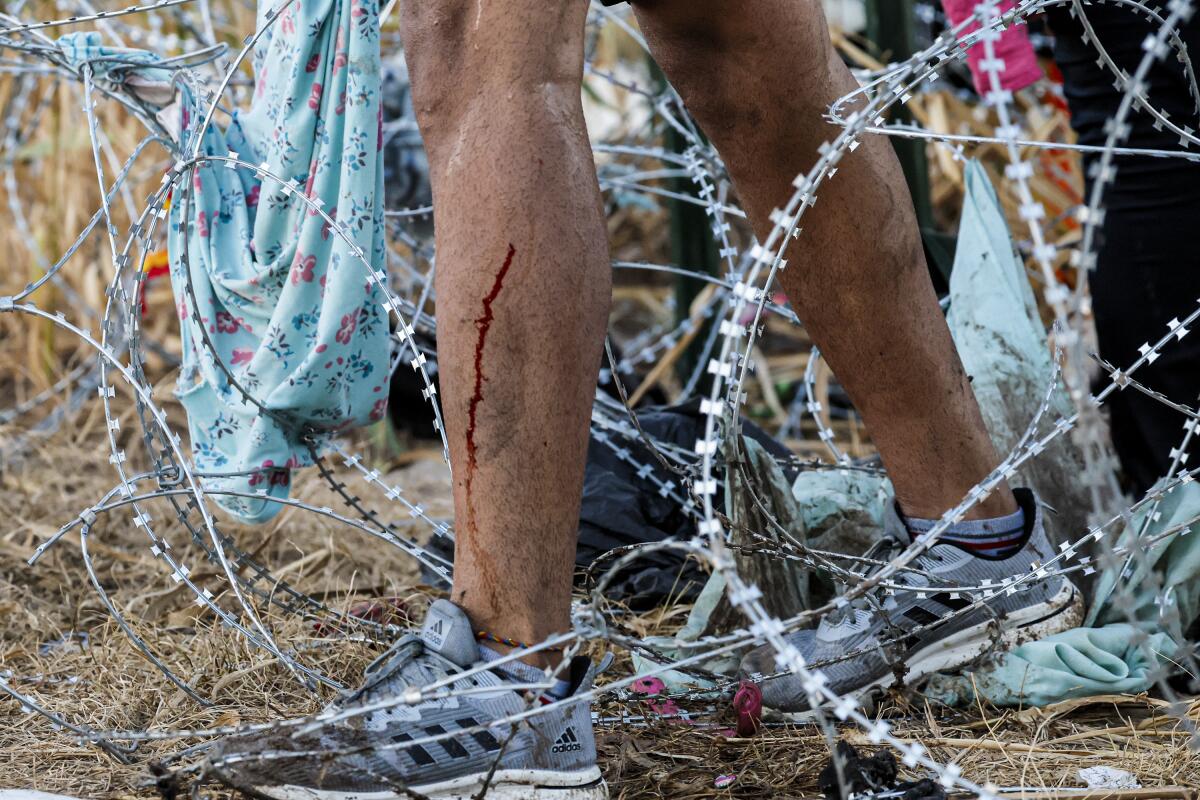

1. A man carefully grips razor wire as he emerges from the Rio Grande. 2. (Robert Gauthier/Los Angeles Times) 3. A man hands a child to a Border Patrol agent after passing through barbed wire on the Rio Grande. (Robert Gauthier / Los Angeles Times)
Here, migrants are organized into lines and are soon put in buses or vans, headed to shelters or holding facilities.
Once allotted court dates, asylum seekers fan out throughout the United States. Abbott recently dispatched chartered buses to Eagle Pass and El Paso to ferry migrants to what he called “self-declared sanctuary cities,” including New York, Washington, Chicago and Los Angeles.
For the Biden administration, immigration has been a fraught issue as the president has sought to convey a more compassionate approach than his predecessor, Donald Trump, while still endeavoring to avoid televised takes of border turmoil.
There was a surge in illicit crossings in the spring in anticipation of the lifting of Title 42 — a public-health rule invoked by Trump that effectively cut off the right to asylum for most migrants, subjecting millions to quick expulsion.
Then came what experts called a “wait and see” period, during which many appeared to hold off attempting to cross illegally.
The Biden administration was worried border crossings would surge after Title 42 expired. Officials, experts and migrants help explain why numbers have fallen instead.
The numbers have been climbing steadily since July.
So many migrants are riding boxcars that Mexico’s largest rail operator, Ferromex, temporarily suspended service on 60 northbound trains last month. The company cited a half-dozen recent injuries or deaths.
The Biden administration says that since May it has removed more than 250,000 people who were in the United States illegally.
But migrants from Venezuela, which has seen more than 7 million people flee economic collapse in recent years, cannot be easily deported, because the two countries lack formal diplomatic relations.
Venezuelans with passports and financial sponsors in the United States are eligible for entry under a humanitarian parole program. The program, which is also open to Haitians, Cubans and Nicaraguans, is capped at a total of 30,000 migrants a month — which falls short of the demand.
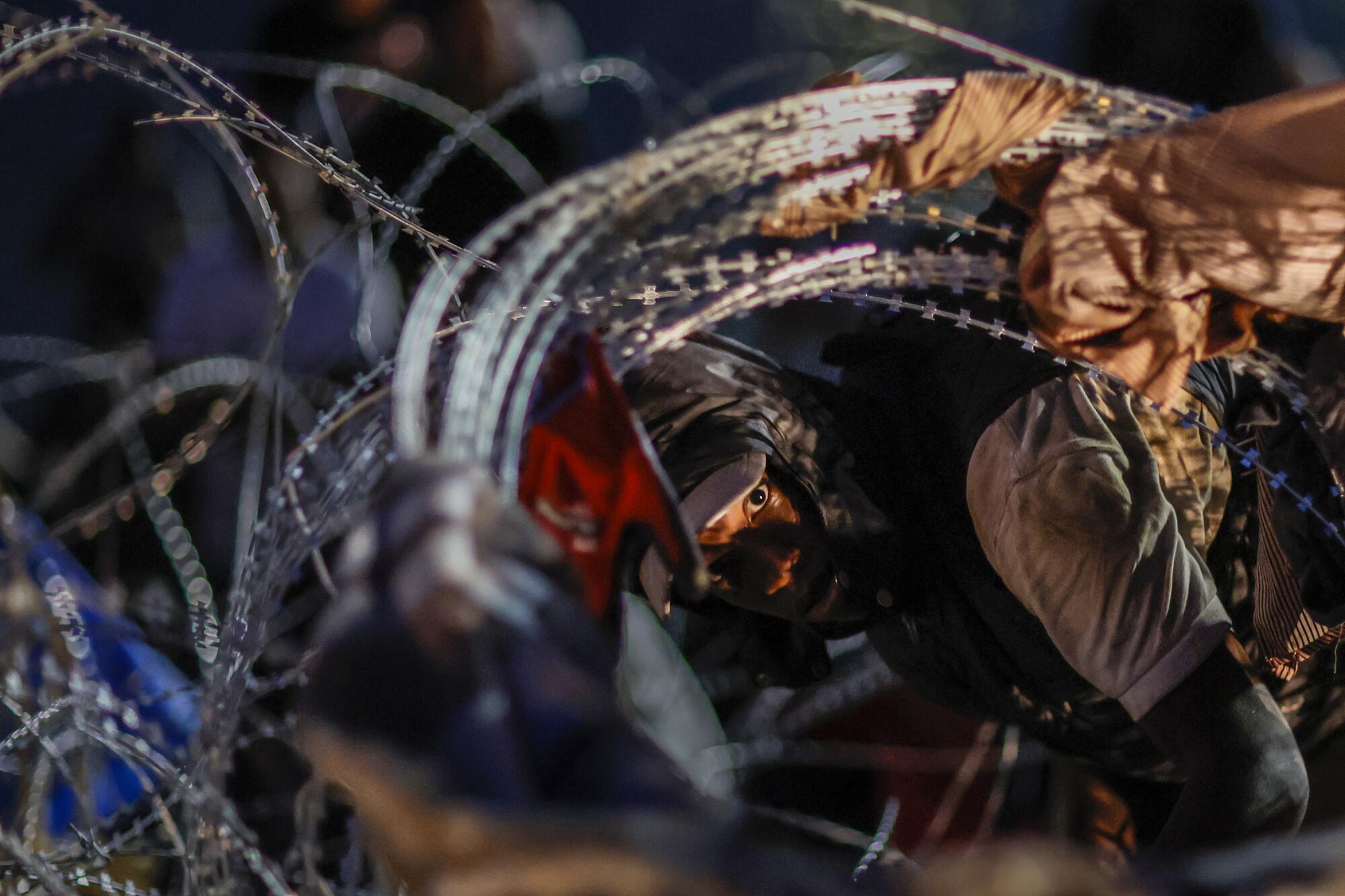
In addition, the U.S. government recently granted “temporary protected status” — a designation for immigrants whose countries are deemed unsafe because of war, civil strife or natural disasters — to 472,000 Venezuelans in the United States as of July 31, allowing them to work legally.
In interviews, Venezuelans said that while they didn’t necessarily understand the details of U.S. policy, they believed they would be allowed to enter the country if they could reach the border.
“Every day, more people are setting off for the Darien, risking their lives, risking the lives of their children,” said Maria Garza, 28, part of a group of young Venezuelans gathered on the Mexican side of the Rio Grande on a recent evening.
Hope is spreading among the tens of thousands of Venezuelans trapped in Mexico that the United States will soon start letting them in again.
Her destination was Washington, D.C., where she has relatives. She also has a sister who recently arrived in Texas.
“We are fleeing because we live in a dictatorship,” said Garza, 28, a college graduate. “Because we don’t earn enough to buy food. Because, as young people, we have no future.”
: :
It had been a month since Garza and her traveling companions left Venezuela. They peered across the river into the United States.
Glints of orange-tinted light from the Border Patrol installation in Eagle Pass rippled on the water. Generators hummed. A freight train rumbled above on the rust-hued Union Pacific International Railroad Bridge. Spectral figures paced back and forth in the dark.
“We want to get this over with,” Garza said. “To move on.”
She and the others began to place backpacks and belongings in plastic trash bags to keep them dry.
A few of the men took off their jeans and stripped down to shorts. Everyone wondered about the shoe question.

“Better go barefoot,” said a figure on the dark shore, not one of the group. “Your sneakers will slip on the rocks. It’s like ice.”
Soon, they were off, a procession of individuals holding hands and stepping gingerly in the water. Several stragglers, including a Honduran man on crutches, picked up the rear. The group quickly reached a small island split between the two countries. The narrow stretch provided a respite before stepping into the capricious current on the U.S. side.
It seems everybody has a close relative in the United States. The exodus is driven by economics.
The Mexican peso is one of the world’s strongest currencies. That’s bad news for citizens who rely on dollars.
In a few minutes, they joined a group already lining up along the shoreline, below the coils of razor wire. However tentatively, they were on U.S. soil.
Behind them were tens of thousands of Venezuelans and other migrants, trekking across the Darien Gap and into Central America, riding atop boxcars through Mexico, on their way.
McDonnell reported from Eagle Pass and Piedras Negras, Mexico. Aleaziz reported from Healdsburg, Calif.
More to Read
Sign up for Essential California
The most important California stories and recommendations in your inbox every morning.
You may occasionally receive promotional content from the Los Angeles Times.
